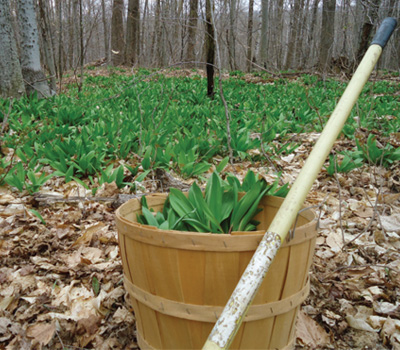

Ramp season in the Berkshires lasts a week to ten days.
The wooded hillsides suddenly turn green as new growth pushes up through last fall’s leaves. It’s the first sign of earth’s abundance after a long winter. In April, having foraged, cleaned and roasted a handful in an iron skillet, I chopped some into an omelette, their fresh green tang running parallel to a chilled glass of sauvignon.
Spring is the time when we check in on sauvignon blanc, and it was on an early spring day in Napa Valley when I met Michael Scholz and Emma Swain at their Dollarhide Ranch, in the eastern foothills of Howell Mountain where the fruit for St. Supéry’s top sauvignon grows in one block of old vines. The bright fruit and the hum of acidity in that wine is with me right now, filed in taste memory somewhere close to the pungent flavor of fresh ramps.
Dollarhide is distinctive enough that it stood out the following week in our sauvignon blanc tastings, with a specific depth of flavor unlike any others on the table, and it got Luke Sykora and me talking about upland sauvignon blanc. After our tastings, he headed to Arkenstone on Howell Mountain to investigate their planting from 1998, and then on to Peter Michael, who grows sauvignon in the volcanic soils of Knights Valley, high into the Mayacamas Range. Further south in the same range, Bob Travers grows high-altitude sauvignon blanc on Mt. Veeder. What Luke discovered while visiting them all was the bedrock they shared—rhyolite, an igneous rock transformed from lava flows.
Pedro Parra, the geologist and terroir consultant interviewed by Patricio Tapia in this issue, describes wines grown in mother rock as structurally different from wines grown in alluvial or colluvial deposits. For him, vines growing in limestone or granite, or perhaps rhyolite, which is similar to granite in its composition, produce wines with a narrow, focused structure, while vines grown in deeper alluvial soils tend to yield wines with broader structures.
These high-altitude sauvignons grown in rhyolite, though grander in a sense than most of the sauvignons grown on the valley floor, do have a tight focus—an elegant structure that is, perhaps, the west coast equivalent of an Appalachian ramp. Springtime energy preserved.
Which leads to the wines of summer—the focus of this issue—with our Value Brands of the Year and our Top 100 Values. If you’re stocking up on wines for summer entertaining, beach vacations and mountain escapes, clip these two shopping lists for some amazing deals.


This story appears in the print issue of June 2012.
Like what you read? Subscribe today.















